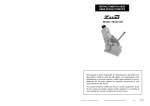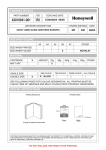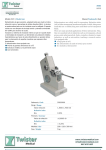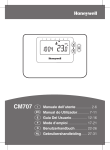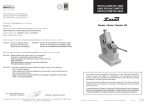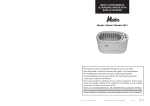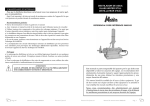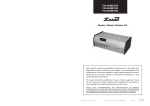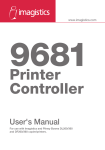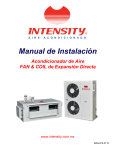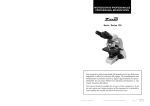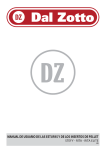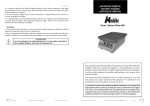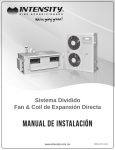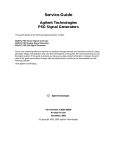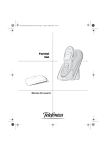Download REFRACTÓMETRO ABBE ABBE REFRACTOMETER
Transcript
REFRACTÓMETRO ABBE ABBE REFRACTOMETER Modelo / Model 315 Este manual es parte inseparable del aparato por lo que debe estar disponible a todos los usuarios del equipo. Le recomendamos leer atentamente el presente manual y seguir rigurosamente los procedimientos de uso para obtener las máximas prestaciones y una mayor duración del mismo. This manual should be available for all users of these equipments. To get the best results and a higher duration of this equipment it is advisable to read carefully this manual and follow the processes of use. Revisión 2 de Julio-04 Manual de instrucciones 50315XXX Pág. 1 CASTELLANO Gracias por haber adquirido este equipo. Deseamos sinceramente que disfrute del Refractómetro Zuzi modelo 315, le recomendamos que cuide el equipo conforme a lo expuesto en este manual. Zuzi desarrolla sus productos haciendo hincapié en la ergonomía y seguridad del usuario. El uso incorrecto o indebido del equipo, puede dar lugar a accidentes y descargas eléctricas, cortocircuitos, fuegos, lesiones, lea el punto de mantenimiento, donde se recogen aspectos de seguridad. La calidad de los materiales empleados en la fabricación y el correcto proceder permitirá disfrutar del equipo por muchos años. Tenga especialmente presente lo siguiente: Este manual es parte inseparable del aparato por lo que debe estar disponible a todos los usuarios del equipo. Debe manipularse siempre con cuidado evitando los movimientos bruscos, golpes, caídas de objetos pesados, manipulación de objetos punzantes. Nunca desmonte el equipo usted mismo, además de perder la garantía podría producir funcionamiento deficiente de todo el conjunto, así como daño a las personas. Para prevenir fuego o descargas eléctricas, evite los ambientes excesivamente húmedos. Cualquier duda puede ser aclarada por su distribuidor: instalación, puesta en marcha, funcionamiento. También puede mandarnos sus dudas o sugerencias a la siguiente dirección de correo Servicio Técnico Zuzi: [email protected]. El fabricante se reserva los derechos a posibles modificaciones y mejoras sobre este manual y equipo. No olvide rellenar y enviar su certificado de garantía en los 15 días siguientes a la compra del refractómetro para disponer de un periodo de garantía de un año. NAME OF THE MANUFACTURER/IMPORTER: AUXILAB, S.L. ADDRESS: Polígono Morea Norte, 8 31191 Beriáin (Navarra) WE STATE THAT: ZUZI REFRACTOMETER SERIES 315 MODELS 50315010 AND 50315000 Are designed and manufactured according to: Directive 89/392/CEE, including the modifications and the national regulations Directive 73/23/CEE modified over the electric security Directive 89/336/CEE modified over the electromagnetic compatibility And that the following harmonized rules have been applied (or part of them): INDICE DE IDIOMAS 1-10 11-19 INDICE DE CONTENIDOS UNE 292-1, UNE 292-2, UNE 292-2/A1, UNE 614-1, UNE 953, UNE 294, UNE 894-1, UNE 894-2, UNE 60204, UNE 61010-1. BERIAIN 23rd June 2004 1. APLICACIONES DEL INSTRUMENTO 2. DESCRIPCIÓN 3. ESPECIFICACIONES TÉCNICAS 4. INSTALACIÓN / PUESTA EN MARCHA 5. MANTENIMIENTO Y LIMPIEZA ANEXO I: TABLA CORRECCIÓN INDICE DE REFRACCION CON LA Tª ANEXO II: FUNDAMENTOS TEÓRICOS ANEXO III: CERTIFICADO CE Manual de instrucciones 50315XXX AUXILAB S.L. that transpose them. ¡ATENCIÓN! NO SE ADMITIRÁ NINGUNA MÁQUINA PARA REPARAR QUE NO ESTÉ DEBIDAMENTE LIMPIA Y DESINFECTADA. Pág. 2 ANNEXE III: CE CERTIFICATE CE DECLARATION OF CONFORMITY ZUZI REFRACTOMETER SERIES 315 of AUXILAB, S.L. for the Directive of Machines (89/392/CEE modified) and the regulations adopted for their transposition LEA DETALLADAMENTE ESTE MANUAL DE INSTRUCCIONES ANTES DE OPERAR CON ESTE EQUIPO CON EL FIN DE OBTENER LAS MÁXIMAS PRESTACIONES Y UNA MAYOR DURACIÓN DEL MISMO. Castellano Inglés ENGLISH Revisión 2 de Julio-04 3 3 4 4 7 8 9 10 Signed by: ALFONSO AINCIBURU SANZ DIRECTOR/MANAGER Polígono Morea Norte, 8 31191 Beriain (Navarra) - Spain. Tel. 948 310 513 Fax 948 312 071 Internet: www.auxilab.es · Email: [email protected] Version 2 July-04 Instruction manual 50315XXX Page 19 ENGLISH ANNEXE II CASTELLANO 1. APLICACIONES Theoretical basis. Refractometry When a light ray gets to the boundary between different media, part of the light is reflected and part is refracted (it goes in the second medium), spreading the latter with an angle and speed different from the ones of the first medium. These two magnitudes can be distinguished by the refractive index, which is a characteristic value for each substance. The refractive index is related to the mass, the charge and the number of particles of the substance through which the luminous radiation is transmitted. There are different types of refractometers, but most of them follow the same principle. The fist principle of a refractometer is agreement with the following Law of Refraction: being n1 and n2 the refractive indexes of the medium at both sides of the boundary between different media, where α´is the incident angle and α" is the angle of refraction. When a light ray goes from an optically dense medium to another medium optically lighter, the incident ray is narrower than the refraction angle. When we change the first so that the second rises 90º, the incident angle is called critical angle. The principle of this refractometer to set the refractive index is based on knowing the critical angle. When the light ray passes over the surface AB from any angle (picture 4), its refraction angle is always bigger than i. If we obser90º A B ve the emerging beam through a telescope, the field of vision appeb ars divided in two halves, one dark and another light. If we place a i the delimiting line of the two halves just in the middle we obtain D C the critical angle. ABCD is the refractive prism whose refractive Picture 4 index is n2. Over the surface AB we place the substance to be measured (liquid or transparent solid) whose refractive index is n1. Law of Refraction: n1 = sen φ x 2. DESCRIPCIÓN Figura 1 - Partes del refractómetro 1 6 Figura 2 - Teclado de membrana 8 2 3 ABBE REFRACTOMETER 1 4 DISPLAY 7 n1 xsenα'= n2 xsenα’’ TEMP READ 2 POWER Thanks to the Law of Refraction we obtain the following equation: n1 xsen90º= xsenα n2 xsenß = sen i φ=α+ß α=φ-ß Transferring this to the first equation we obtain that: n1 = n2 x sen (α−β) = (sen φ x cosβ - cosφ x senβ) n2²x sen²β = sen² i n2²x (1-cos²β) = sen² i n2²- n2² x cos ²β = sen² I cosβ = El Refractómetro se utiliza para medir índices de Refracción (nD) de líquidos que sean transparentes o translúcidos y de sólidos, siendo el uso más frecuente con líquidos transparentes. El Refractómetro Zuzi 315 dispone de circuito en su prisma para termostatizar la muestra a la temperatura a la que deseamos trabajar. Consulte las tablas adjuntas para la corrección del índice de refracción con la temperatura. El índice de refracción es una importante constante óptica en las sustancias, y pueden ser utilizadas para determinar el comportamiento óptico, pureza, concentración, dispersión, etc. Es posible calcular el porcentaje de azúcar contenido en disoluciones de sacarosa en un rango de 0 a 95 grados Brix, lo que se corresponde con un índice de refracción de 1.333 a 1.531. Este equipo dispone de una amplia gama de aplicaciones prácticas, siendo una herramienta imprescindible en la industria petrolera, de aceites y grasas, pinturas, farmacéutica, alimentaría, cosmética, química, y azucarera, así como en universidades y centros de investigación y docencia. BX-TC n 0 BRIX 9 5 6 7 5 1.1. Ocular. 1.2. Mando de corrección de la dispersión. 1.3. Tornillo de calibración. 1.4. Membrana y pantalla. 1.5. Mando de regulación. 1.6. Prismas termostetizables. 1.7. Iluminador articulado con lente condensadora. 1.8. Toma de corriente (base Schuko). 1.9. Salida RS 232. n2²-sen² i n2² n2²-sen² i - cosφ−sen i 2.1. Pantalla digital. 2.2. Power. Interruptor de encendido y apagado del equipo. 2.3. Read. Botón de lectura. 2.4. Temp. Muestra la temperatura. 2.5. BX-TC. Muestra la lectura en grados Brix con corrección de la temperatura. 2.6. nD. Muestra la lectura en índice de refracción. 2.7. BRIX. Muestra la lectura en grados Brix. The refractive angle φ and the refractive index n2 of the prism are known, so as we know the critical angle i, we can obtain the refractive index of the sample. Page 18 Instruction manual 50315XXX 3 4 Version 2 July-04 Revisión 2 de Julio-04 Manual de instrucciones 50315XXX Pág. 3 CASTELLANO 3. ESPECIFICACIONES TÉCNICAS Rango de medida Indice de Refracción º Brix con corrección Tª º Brix Precisión de las medidas Indice de Refracción Brix con corrección Tª º Brix Temperatura Rango del display Corrección de Brix versus Tª Medidas exteriores Peso Suministro eléctrico Fusible ENGLISH ANNEXE I Correction chart of the refractive index with the temperature of the distillate water 1´3000 a 1´7000 0 a 95% 0 a 95% Temperature º 10 11 12 13 14 15 16 17 18 19 20 21 22 23 24 25 26 27 28 29 30 31 32 33 34 35 36 37 38 39 40 ± 0´0002 ± 0´1% ± 0´1% 0 a 50 ºC 15-45ºC 330 x 180 x 380 mm 10 Kg 220V±10% 50-60Hz 250V 1A Nota: RS232 parámetros: Baudios 2400, Datos 8, Stop 1. El control de flujo es hardware y sin paridad. 4. INSTALACIÓN / PUESTA EN MARCHA Inspección preliminar Desembale el refractómetro, quite la protección de poliespan en la que viene encajada y retire el plástico que la envuelve, asegúrese que no presenta ningún daño debido al transporte. De ser así, comuníquelo inmediatamente a su suministrador. Guarde el embalaje, siempre se deben realizar las devoluciones en su embalaje original con todos los accesorios suministrados. Compruebe los accesorios que usted debe recibir junto al equipo: - Refractómetro - Los siguientes accesorios se adjuntan en estuche: a) Pieza Test (1,51685). b) Aceite de bromo naftaleno. c) Dos lámparas 6,3V y 2,5W. d) Destornillador. e) Cable de red Schuko estándar. f) Manual de uso. g) Certificado de garantía. No aceptaremos ningún equipo en periodo de devolución sin que vengan en su embalaje original. Pág. 4 Manual de instrucciones 50315XXX Revisión 2 de Julio-04 Version 2 July-04 Refractive Index 1.33369 1.33364 1.33358 1.33352 1.33346 1.33339 1.33331 1.33324 1.33316 1.33307 1.33299 1.33290 1.33280 1.33271 1.33261 1.33250 1.33240 1.33229 1.33217 1.33206 1.33194 1.33182 1.33170 1.33157 1.33144 1.33131 1.33117 1.33104 1.33090 1.33075 1.33061 Instruction manual 50315XXX Page 17 ENGLISH CASTELLANO Avoid spilling water on the control panel. During its functioning keep the equipment away from dangerous materials such as Instalación Antes de comenzar a utilizar el instrumento es conveniente familiarizarse con sus componentes y fundamentos básicos, así como con las funciones de sus controles. inflammable material or liquids. Do not put the refractometer near any warm supply (burners, blowlamp…), do not expose directly to the sun. If you find out that there is degradation of the cement that joins the inferior prism to the carcase, disconnect the equipment immediately from the net and get in touch with the ZuziTechnical Service. If you are not going to use the equipment during a long period of time please make sure that it is unplugged from the net. Never dismantle the different pieces of the refractometer to repair yourself, since it could produce a defective use of the whole equipment and a loss of the product's warranty. For the overhaul of the equipment please contact the Zuzi Technical Service. Fabricated under the European regulations. 5. MAINTENANCE AND CLEANING To get the best results and a higher duration of this equipment it is necessary to follow the following recommendations. Note: All the processes of use mentioned before will not have any value unless you keep a continued and careful maintenance. Please follow the processes of use of this manual This manual should be available for all users of this equipment Do always use original components and supplies. Other devices can be similar but they can damage the equipment. After every use the refraction prisms should be cleaned with a cloth that does not give off fluff, damped with water or with neutral products (water with soap without abrasives). Solid impurities should not exist in the liquid samples and the solid samples should have polished and plane faces to avoid scratching the prism. If the lamp gets blown, change it by taking off the condensed lateral lens and then putting the lens on again. When you are not going to use the refractometer for a long period keep it in its box with a desiccant substance (Silica Gel). Avoid damages and rubbing between the prisms for an optimum functioning of the refractometer; it can be damaged by samples that contain crystalline or big fragments. If there is any damage do not try to repair the equipment yourself, since it could produce a defective use of the whole equipment and a loss of the product's warranty. It can also cause damages to the electric system. For all your doubts please contact Zuzi´s official Service. Cleaning For the cleaning of the different pieces of the equipment, we recommend the use of neutral products that do not contain abrasive agents, e.g. some drops of cleaning glass soap reducing it in water. Never pour the dissolution over the equipment, always damp a soft cloth in the soap and water. Page 16 Instruction manual 50315XXX Version 2 July-04 LEA DETALLADAMENTE ESTE MANUAL DE INSTRUCCIONES ANTES DE OPERAR CON ESTE EQUIPO CON EL FIN DE OBTENER LAS MÁXIMAS PRESTACIONES Y UNA MAYOR DURACIÓN DEL MISMO. Coloque el refractómetro sobre una mesa horizontal, plana y estable, creando un espacio libre de al menos 30 cm por cada lado. No coloque el refractómetro en zonas próximas de excesivo calor (mecheros, sopletes...), evite exponer directamente a la luz del sol, etc. Durante el funcionamiento debe estar fuera del espacio libre cualquier material peligroso o líquido inflamable. El refractómetro se suministra con un cable Schuko estándar. Inserte el cable de alimentación de corriente alterna (CA) a la base de corriente 220V ±10% 50-60Hz provista de toma de tierra y por el otro extremo al conector del refractómetro. Ni el fabricante ni el distribuidor asumirán responsabilidad alguna por los daños ocasionados al equipo, instalaciones o lesiones sufridas a personas debido a la inobservancia del correcto procedimiento de conexión eléctrica. La tensión debe ser de 220V ±10% 50-60Hz. Cuando no vaya a hacer uso del refractómetro por largos periodos de tiempo asegúrese de que esté desconectado de la red. Puesta en funcionamiento Conecte el Refractómetro a la corriente. Presione el interruptor Power (2.2); se ilumina (1.8) al mismo tiempo que en la pantalla digital (2.1) aparece "Welcome" e inmediatamente después "Waiting", mostrando a continuación "0.0000". La pantalla muestra todas las unidades que pueden hacerse pero, por defecto, Figura 3 como unidad principal aparece en nD. Abra la unidad (1.6) donde están localizados los prismas y límpielos cuidadosamente con un paño que no desprenda pelusa ni raye los prismas impregnado de agua o con productos neutros. Ponga la muestra en la superficie del prisma de refracción. Si la muestra es líquida, ponga dos gotas sobre la superficie de trabajo en el prisma inferior, coloque el prisma superior y ya se puede realizar la medida. Si la muestra es sólida, deberá tener una cara plana y pulida sobre la que, una vez limpia, añadiremos unas gotas de Bromo naftaleno. Se coloca la muestra sobre el prisma asegurándose de que hace buen contacto de ambas superficies planas y buena distribución del bromo naftaleno; no hace falta cerrar con el prisma superior para realizar medidas de sólidos. Gire el brazo del iluminador (2.7) hasta que consiga una buena iluminación, en el lugar donde podamos ver más contraste entre las zonas clara y oscura. Gire el mando selector (1.5) hasta hacer coincidir la línea divisoria claro / oscuro en las líneas cruzadas. Con el mando de corrección de la dispersión (1.2) hacemos lo más nítida posible la línea divisoria. Confirme que dicha línea coincide exactamente en el centro de las líneas cruzadas y oprima el botón de lectura Read (2.3) (ver fig. 3). Revisión 2 de Julio-04 Manual de instrucciones 50315XXX Pág. 5 CASTELLANO ENGLISH Cuando se pulsa el botón de lectura Read, desaparece el "00000" de la pantalla, aparece When you press the button Read, the "00000" will disappear from the screen, you will "Waiting" y obtenemos el valor del índice de refracción de la muestra. La elección del modo de lectura se puede hacer bien antes de hacer la primera lectura nada más encender el equipo, o bien una vez realizada. Cuando en la pantalla sale el índice de refracción, se puede cambiar. Nota: Una vez pulsado el botón Read espere a que salga la medida en la pantalla; si pulsa repetidamente este botón causará un bloqueo en el sistema dejando inutilizado el equipo. En la pantalla se muestran todas las unidades de medida. No obstante, si lo que queremos es realizar la lectura de la medida en grados Brix, grados Brix con ajuste de la temperatura o bien saber la temperatura a la que se está realizando la medida, pulsamos el botón adecuado situado en el panel de mandos (ver fig. 2). En la pantalla digital aparece en la forma principal la unidad en la que estamos trabajando. Cuando se quiera trabajar en grados Brix, presione el botón "BRIX" y como imagen principal aparece la medida en grados brix; el mismo procedimiento se sigue para trabajar en índice de refracción "nD" y en brix con ajuste de temperatura "BX-TC", si se desea ver como unidad principal. Nota: Cada vez que cambiamos la muestra tenemos que pulsar Read (2.3) para que se realice la medida. Si queremos medir la temperatura de la muestra pulsamos Temp y en la pantalla aparece el valor. Esta medida se puede realizar en todo momento excepto cuando en la pantalla aparece "Waiting", después de que el botón Read ha sido presionado. Si guarda el equipo en un lugar diferente de donde va a realizar la medida de las muestras, hay que tener en cuenta que debe adaptarse a la temperatura ambiente del lugar de trabajo; de lo contrario nos estará dando la temperatura a la que se encuentra el equipo, dependiendo de dónde haya estado almacenado. Después de realizar las medidas oportunas disuelva la muestra bien con agua (cuando la muestra es una disolución azucarada) o utilizando el disolvente adecuado para cada tipo de muestra, y posteriormente limpiar los prismas cuidadosamente con un trapo que no suelte pelusa y que no raye, humedecido con productos neutros. see "Waiting" and we will obtain the refractive index of the sample. You can make the choice of the reading mode once the first reading is done immediately after turning on the equipment or once it is made. When the refractive index appears on screen, it can be changed. Note: Once the Read button is pressed, wait until the measure appears in screen; if you press continuously this button it will cause an obstruction in the system leaving the equipment useless. In the screen all the measure units are shown but, if we want to make a reading in Brixº with adjustment to temperature or we want to know the temperature at which the measures are being made, we will press the correct button situated in the control panel (see picture 2). The digital screen will show the principal form of the unit we are working with. When we want to work in Brixº, press the "BRIX" button and, as the principal measure, you will see Brixº. The same procedure is followed to work with the refractive index "nD" and in brix with the temperature adjustment "BX-TC", if you wish to see it as the principal unit. Note: Each time we change the sample we have to press Read (2.3); this way the measurement will take place. If we want to measure the temperature of the sample we will press Temp. This measure can be made in every moment except when in the screen we can read "Waiting", after the button Read has been pressed. If you keep the equipment in a different place of that where you make the measures, bear in mind that it has to adapt to the environment’s temperature of the working place; if not, it will be giving us the temperature at which the equipment is, depending where it has been kept. After making the appropriate measurements dissolve the sample with water (when the sample is a sweet dissolution) or use the suitable dissolvent for each sample; after that clean the prism carefully with a special cloth that does not give off fluff and does not scratch, damped with neutral products. Calibración Los Refractómetros deben calibrarse periódicamente, para lo que se usa agua destilada o la pieza test. Procediendo de la forma indicada en el capítulo anterior obtendremos el valor del índice de refracción. Si no coincide con el valor conocido del agua destilada a 20º C (1´33299) o de la pieza test a 20º C (grabado en su parte superior), introduciremos el destornillador suministrado en el pequeño orificio que se halla en el mando de corrección de la dispersión. Haciéndolo girar subiremos o bajaremos las líneas cruzadas hasta conseguir que la lectura coincida con los valores conocidos. Vaya comprobando al mover las líneas cruzadas que el valor que lee el equipo es el valor referencia. Calibration The refractometers should be calibrated periodically, for this we use distillate water for the test piece. If you proceed in the correct way, as stated in the previous chapter, you will obtain the refractive index. If it does not coincide with the known value of the distillate water at 20º C (1´33299) or with the test piece at 20ºC (engraved in the upper part), we will insert the screwdriver that is suministrated in the small hole located in the dispersion correction handle. By turning it we will make the crossed lines go up or down until we make the reading fit with the known values. You will have to check when moving the crossed lines that the value read by the equipment is the value of reference Seguridad Security Los refractómetros deben ser utilizados por personal cualificado previamente, conocien- The refractometers should be used by qualified staff, that is aware of the use of the equip- do el equipo y su manejo mediante el manual de uso. ment by the instruction manual. Please put the refractometer on top of a horizontal, plane and stable table making a free space of at least 30 cm per side. Coloque el refractómetro en una mesa horizontal y plana, creando un espacio libre alrededor de ella de 30 cm. Pág. 6 Manual de instrucciones 50315XXX Revisión 2 de Julio-04 Version 2 July-04 Instruction manual 50315XXX Page 15 ENGLISH CASTELLANO Installation Before using this instrument, it is convenient for you to familiarize with its components and basic essentials. Evite que caiga agua o cualquier líquido en la membrana de control. Durante el funcionamiento deben estar fuera del espacio libre alrededor del refractó- PLEASE READ THOROUGHLY THE INSTRUCTIONS BEFORE CONNECTING AND OPERATING WITH THIS EQUIPMENT. Please put the refractometer on top of a horizontal, plane, stable table making a free space at least at 30 cm per side. Do not put the refractometer near any warm supply (burners, blowlamp…), do not expose directly to the sun, etc. During its functioning, do not use the equipment near fluids that can give off steams or produce explosive or inflammable mixtures. The refractometer is suministrated with a Schuko standard wire. Please insert the wire that feeds the A/C in the base of current 220V ±10% 50-60Hz provided with earth wire.. The manufacturer and the distributor will not assume any responsibility for the damages produced to the equipment in its installing or damages to persons suffered by the wrong use of the electric connection. The tension should be 220V ±10% 50-60Hz. If you are not using the refractometer during a long period of time please make sure it is disconnected from the net. Setting up Connect the refractometer to the current net. Press Power (2.2); it will light up (1.8) at the same time as the digital screen (2.1) shows "Welcome"; immediately after you will read "Waiting". The screen will show all the units that can be made, but by defect, as the principal until it will show en nD. Open the unit (1.6) where the prism are located and clean them carefully with a special cloth that will not harm or damage the prism -free from dust, it has to be impregnated with water and with neutral products-. Put the sample on the surface of the refractive prism. If the sample is liquid, put two drops over the working surface in the lower prism, positionate the superior prism and now you can make the measures. If the sample is solid,it should have a plane and polished face over which you will, once it is clean, put some drops of Brome Naphthalene. We will put the sample over the prism making sure that there is a good contact of both plane surfaces and a good distribution of the brome naphthalene. It is not necessary to close with the superior prism to make measures of solids. Turn the illuminator arm (2.7) until you get a good illumination, where we can see more contrast between the clear and dark zones. Turn the selector handle (1.5) until you make the divisor line coincide clear/dark in the crossed lines. With the handle of the dispersion correction (1.2) we will make the most possibly sharp/clear the divisor line. Confirm that this line coincides exactly with the centre of the crossed lines and press the button Read (2.3) (see picture 3). Picture 3 Page 14 Instruction manual 50315XXX Version 2 July-04 metro líquido y material inflamable. No coloque el refractómetro en zonas próximas a excesivo calor (mecheros, sopletes, calefacciones...) y evite que incida directamente sobre él la luz del sol. Si comprueba degradación o desprendimiento del cemento que une el prisma inferior a la carcasa, desconecte inmediatamente el equipo de la red y consulte con el Servicio Técnico Zuzi. Asegúrese de desconectar de la red cuando no vaya a hacer uso del refractómetro por periodos largos de tiempo. No desmonte el refractómetro usted mismo para repararlo, además de perder la garantía puede provocar el mal funcionamiento de todo el equipo. Para cualquier reparación póngase en contacto con el Servicio Técnico Zuzi. Fabricadas según la norma europea. 5. MANTENIMIENTO Y LIMPIEZA Para un adecuado funcionamiento del refractómetro es necesario seguir algunas recomendaciones. Nota: Todas las normas de utilización citadas anteriormente carecerán de valor sino se realiza una continua labor de mantenimiento. Siga las instrucciones y advertencias relativas a este manual. Tenga este manual siempre a mano, para que cualquier persona pueda consultarlo. Utilice siempre componentes y repuestos originales. Puede ser que otros dispositivos sean parecidos, pero su empleo puede dañar el equipo. Después de cada uso se deben limpiar los prismas de refracción con un paño que no suelte pelusa bien con agua o con productos neutros (agua jabonosa que no contenga abrasivos). No deben existir impurezas sólidas en las muestras líquidas y las muestras sólidas deben tener las caras pulidas y planas para evitar rayar el prisma. Si se funde la lámpara, cámbiela sacando la lente condensadora lateralmente y vuelva a colocar la lente. Cuando no utilice el refractómetro durante largos períodos de tiempo guárdelo en su caja con alguna sustancia desecante (Silica Gel). Evite daños y rozamientos entre los dos prismas para un funcionamiento óptimo del refractómetro, puede ser dañado por muestras que contengan sustancias cristalinas o fragmentos de tamaño considerable. No intente repararlo usted mismo, además de perder la garantía puede causar daños en el funcionamiento general del equipo así como lesiones a la persona (quemaduras, heridas...) y daños a la instalación eléctrica. Limpieza Para la limpieza de las diferentes piezas del aparato, recomendamos se utilicen productos neutros que no contengan agentes abrasivos como por ejemplo unas gotas de jabón de limpieza de cristal rebajado en agua. No verter nunca el preparado sobre el equipo, acostúmbrese siempre a humedecer un trapo suave con dicho producto. Revisión 2 de Julio-04 Manual de instrucciones 50315XXX Pág. 7 CASTELLANO ANEXO I ENGLISH 3. TECHNICAL SPECIFICATIONS Tabla de corrección del índice de refracción con la temperatura para agua destilada Temperatura º 10 11 12 13 14 15 16 17 18 19 20 21 22 23 24 25 26 27 28 29 30 31 32 33 34 35 36 37 38 39 40 Indice de Refracción 1.33369 1.33364 1.33358 1.33352 1.33346 1.33339 1.33331 1.33324 1.33316 1.33307 1.33299 1.33290 1.33280 1.33271 1.33261 1.33250 1.33240 1.33229 1.33217 1.33206 1.33194 1.33182 1.33170 1.33157 1.33144 1.33131 1.33117 1.33104 1.33090 1.33075 1.33061 Measuring range Refractive Index º Brix with Te correction º Brix Measure’s precision Refractive Index Brix with Te correction º Brix Temperature Display range Brix correction versus Te Exterior measures Weight Electric supply Fuse 1´3000 to 1´7000 0 to 95% 0 to 95% ± 0´0002 ± 0´1% ± 0´1% 0 to 50 ºC 15-45ºC 330 x 180 x 380 mm 10 Kg 220V±10% 50-60Hz 250V 1A Note: RS232 parameters: Bauds 2400, Data 8, Stop 1. The flow control is hardware and without parity. 4. INSTALLATION / SETTING UP Preliminary inspection Unwrap the Refractometer, take of the involving plastic and take of the poliespan protection in which it comes fitted, please make sure that it does not present any damage because of the shipment. If it does please communicate to your transport agent or suministrator immediately, so that they can make the claims in the correct time limit. Please keep the original wrapping; you will always need it for returns enclosed with all the accessories suministrated. Please check that all the accessories are enclosed with the equipment: - Refractometer - The following articles are enclosed in the case: a) Test piece (1,51685). b) Wrapping of mono brome naphthalene. c) Two lamps 6,3V and 2,5W. d) Screwdriver. e) Standard Schuko cable. f) Manual of use. g) Warranty Certificate. We will not accept any return of equipments in warranty unless they are in their original wrapping. Pág. 8 Manual de instrucciones 50315XXX Revisión 2 de Julio-04 Version 2 July-04 Instruction manual 50315XXX Page 13 ENGLISH 1. APLICATIONS OF THE EQUIPMENT ANEXO II The Refractometer is used to measure the refractive index (nD) of transparent or translucent liquids and solids, being more used the transparent liquids. The Zuzi Refractometer 315 RS232 has a circuit in its point of view for the thermostatization of the samples at the temperature we need for working. For the correction of the refractive index with the temperature please go through the enclosed tables. The refractive index is an important optic constant in the substances, and it can be used to determine the optic behaviour, purity, concentration, dispersion, etc. It is possible to calculate the sugar percentage contained it the sacarose dissolutions in a range between 0 and 95 Brixº, what matches with a refractive index of 1.333 to 1.531. This equipment has an extensive range of practical applications, being an essential tool in the petrol industry, of oil and grease, paintings, pharmacy, food, cosmetic, chemistry, and sugar, also in universities and centres of investigation and teaching. 2. DESCRIPTION Picture 1 - Parts of refractometer 1 6 Picture 2 - Membrane keyboard 8 2 3 ABBE REFRACTOMETER 1 4 DISPLAY 7 TEMP READ 2 POWER BX-TC n 0 3 5 6 Fundamentos teóricos. Refractometría Cuando un rayo de luz llega a la superficie de separación entre dos medios distintos, parte de la luz se refleja y otra se refracta (entra en el interior del segundo medio), propagándose este último con un ángulo y una velocidad diferente al del primer medio. Estas dos magnitudes se pueden caracterizar mediante el índice de refracción, que es un valor característico para cada sustancia. El índice de refracción está relacionado con la masa, la carga y el número de partículas de la sustancia a través de la cual se transmite la radiación luminosa. Los refractómetros pueden ser de distintos tipos pero la mayoría se basan en el mismo principio. El principio básico de un refractómetro está acorde con la siguiente Ley de Refracción: Siendo n1 y n2 los índices de refracción del medio a ambos lados del límite entre medios distintos, donde α’ es el ángulo incidente y α’’ el ángulo de refracción. Cuando un haz luminoso pasa de un medio ópticamente más denso a otro ópticamente más ligero, el ángulo de incidencia es menor que el ángulo de refracción y, si cambiamos el primero hasta que el segundo llegue a ser de 90º, en este caso el ángulo de incidencia le llamamos ángulo crítico. El principio de este refractómetro para determinar el índice de refracción se basa en determinar el ángulo crítico. Cuando el haz luminoso cae sobre la superficie AB desde cualquier 90º ángulo (fig. 4), su ángulo de refracción es siempre mayor que i. Si obserA B vamos el haz emergente a través del telescopio, aparece el campo visub a al dividido en dos mitades, una oscura y otra clara. Si situamos la línea i que delimita las dos mitades justo en el centro hallamos la posición del D C ángulo crítico. ABDC es el prisma de refracción cuyo índice de refracción es n2. Sobre la superficie AB se coloca la muestra a medir (líquido Figura 4 o sólido transparente) cuyo índice de refracción es n1. 4 Ley de Refracción: BRIX 9 7 5 1.1. Eyepiece 1.2. Correction and dispersion control 1.3. Calibration screw 1.4. Membrane and screen 1.5. Regulation control 1.6. Thermostatization prism. 1.7. Articulated illuminator with condensing lens. 1.8. Power point (Schuko base). 1.9. Output RS 232. CASTELLANO 2.1. Digital screen. 2.2. Power. On of interruptor of the equipment. 2.3. Read. Lecture button. 2.4. Temp. It shows the temperature. 2.5. BX-TC. It shows the Brixº with the temperature correction. 2.6. nD. It shows the reading of the Refractive Index. 2.7. BRIX. It shows the reading in Brixº. n1 xsenα'= n2 xsenα’’ Por la Ley de Refracción obtendremos la siguiente ecuación: n1 xsen90º= xsenα n2 xsenß = sen i φ=α+ß α=φ-ß Poniendo esto en la primera ecuación tenemos: n1 = n2 x sen (α−β) = (sen φ x cosβ - cosφ x senβ) n2²x sen²β = sen² i n2²x (1-cos²β) = sen² i n2²- n2² x cos ²β = sen² I cosβ = n1 = sen φ x n2²-sen² i n2² n2²-sen² i - cosφ−sen i El ángulo de refracción φ y el índice de refracción n2 del prisma son conocidos, luego al conocer el ángulo crítico i, podemos conocer en índice de refracción de la muestra. Page 12 Instruction manual 50315XXX Version 2 July-04 Revisión 2 de Julio-04 Manual de instrucciones 50315XXX Pág. 9 CASTELLANO ANEXO III: CERTIFICADO CE AUXILAB S.L. DECLARACIÓN CE DE CONFORMIDAD REFRACTÓMETRO ZUZI SERIE 315 de Auxilab,S.L a la Directiva de Máquinas (89/392/CEE modificada) y a las reglamentaciones adoptadas para su transposición NOMBRE DEL FABRICANTE / IMPORTADOR: AUXILAB, S.L. DIRECCIÓN: Please bear in mind the following: Polígono Morea Norte, 8 31191 Beriáin (Navarra) REFRACTÓMETRO ZUZI SERIE 315 MODELOS 50315010 Y 50315000 Esta diseñado y fabricado de acuerdo a: Directiva 89/392/CEE, incluidas las modificaciones de la misma, y las reglamentaciones nacionales que la transponen. Directiva 73/23/CEE modificada sobre seguridad eléctrica. Directiva 89/336/CEE modificada sobre compatibilidad electromagnética. Y que se han aplicado las siguientes normas armonizadas (o parte de ellas): UNE 292-1, UNE 292-2, UNE 292-2/A1, UNE 614-1, UNE 953, UNE 294, UNE 894-1, UNE 894-2, UNE 60204, UNE 61010-1. heavy objects, and manipulation of sharp objects. Never dismantle the different pieces of the Refractometer to repair yourself, since it could produce a defective use of the whole equipment and a loss of the product warranty. To avoid fire o electric discharges, avoid humid environments. If you have any doubt about setting up, installation, functioning do not hesitate in contacting your distributor or our ZUZI Technical Assistant Department by email [email protected] The manufacturer reserves the right to modify or improve the manual or equipment. Please do not forget filling the Warranty Certificate and send it before 15 days after the date of purchase. ATTENTION!! IF AN EQUIPMENT IS NOT PROPERLY CLEAN AND DISINFECTED IT WOULD NOT BE ALLOWED TO REPAIR BY OUR TECHNICAL SERVICE. INDEX OF LANGUAGES Spanish English 1-10 11-19 INDEX OF CONTENTS BERIAIN a 23 de Junio de 2004 Fdo: ALFONSO AINCIBURU SANZ DIRECTOR/GERENTE Polígono Morea Norte, 8 31191 Beriain (Navarra) - Spain. Tel. 948 310 513 Fax 948 312 071 Internet: www.auxilab.es · Email: [email protected] Manual de instrucciones 50315XXX TO GET THE BEST RESULTS AND HIGHER DURATION OF THE EQUIPMENT IT IS ADVISABLE TO READ THOROUGHLY THIS MANUAL BEFORE OPERATING WITH THE EQUIPMENT. This manual should be available for all the users of these equipments We should manipulate carefully avoiding the sudden movements, knocks, free fall of DECLARAMOS QUE: Pág. 10 ENGLISH Thank you for choosing this equipment. We sincerely wish that you enjoy working with your Zuzi Refractometer model 315 RS232; we highly recommend looking after this equipment according to what is stated in this manual. Zuzidevelops its products being remarkable in the ergonomics and security of its user. The incorrect use of the equipment can cause accidents and electric discharges, circuit breakers, fires, damages, please read the point of maintenance, where we expose the security notes. The correct using of the equipment and its good quality will permit you to enjoy this equipment for years. Revisión 2 de Julio-04 1. APLICATIONS OF THE EQUIPMENT 2. DESCRIPTION 3. TECHNICAL SPECIFICATIONS 4. INSTALLATION/SETTING UP 5. MANTEINANCE AND CLEANING ANNEXE I: CORRECTION CHART OF REFRACTIVE INDEX WITH T ª ANNEXE II: THEORETIC FOUNDATIONS ANNEXE III: CE CERTIFICATE Version 2 July-04 Instruction manual 50315XXX Page 11 12 12 13 13 16 17 18 19










